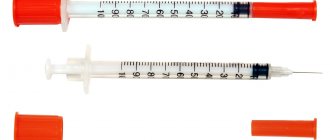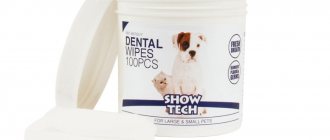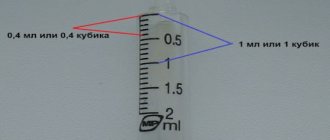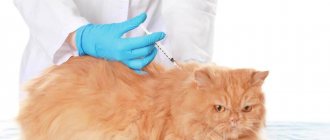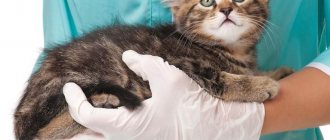If the pet is seriously ill, the loving owner has to learn how to give injections to the cat in the withers or muscles. Even without medical skills, this manipulation is not difficult to master. The main thing is to cast aside all fears. In addition, this will speed up the animal’s recovery process and save the family’s expenses (no need to take the cat to the veterinarian several times a day or pay for a day hospital stay).
Let's find out which injections you can do yourself, and in which cases only a veterinarian performs the manipulations.
General rules
Often, the veterinarian prescribes a course of parenteral injections for the cat, which are placed subcutaneously (in the withers area), in the thigh muscle or shoulder. In order to inject a cat correctly and without consequences (in the withers area or muscle), it is important to know a few rules:
- Only a warm solution can be administered (this is especially true for vaccines and drugs that are stored in the refrigerator). The medicine should be at approximately room temperature. This can be achieved if you take out the bottle in advance (2-3 hours before the procedure) or warm it in warm water. If this rule is neglected and a cold solution is introduced, there is a high probability of the formation of difficult-to-absorbable infiltrates.
- It is necessary to prepare several spare syringes. Often you have to draw liquid from a bottle with an aluminum cap, and this leads to the formation of nicks on the needle, which causes additional pain for the cat when administering the medicine. If the solution was pre-mixed, viscous or poorly dissolved, the needle cavity becomes clogged. In such cases, it is recommended to draw the drug into the syringe with one needle, then replace it with a new one.
- Always expel the air from the syringe cavity before injecting. Otherwise, there is a risk of a bump or bruise. This offense will not bring a mortal threat, but will complicate further injections.
To remove air bubbles, use a finger on the body of the syringe or rotating movements to collect all the small bubbles into one large one and then remove it.
Syringes are different and sometimes it is extremely difficult to remove all the bubbles. In this case, when injecting the solution, it is necessary to hold the syringe piston vertically upward (the medicine will leave, but the air will remain in the syringe).
- Carefully read the instructions for the prescribed drugs, especially if you need to combine several components (for example, when vaccinating or creating complex solutions). In such processes, mixing sequence is important for optimal dissolution.
If the doctor prescribed several injections in one period of time, then it is worth checking about the possibility of combining solutions together. If this is contraindicated, then it is necessary to inject with a short time interval.
- Change injection sites if you have to do them frequently. Subcutaneous injections can be given to the cat at the withers (scruff), in the area of the shoulder blades or groin. The withers are the highest point of the body and are located on the spine between the cat's shoulder blades. Moreover, the skin on the withers is much thicker and more difficult to pierce with an insulin syringe than that above the shoulder blades.
Intramuscular injections are given to cats in both the hind (pelvic) and fore (thoracic) limbs.
- Determine on your own the method of administering the medication, based on the volume or dose (this only applies to those medications that can be administered by any parenteral route, bypassing the gastrointestinal tract). Large volumes of medications (over 3-5 ml) are good to inject into the cat’s withers (the skin stretches well and the likelihood of bumps forming is reduced). Solutions in a volume of up to 3 ml can be safely injected into the paw, and their effect will appear a little faster.
For example, the doctor prescribed 3 ml injections to the cat in the withers area or muscle (the injection point is at the discretion of the owner). Injecting the drug subcutaneously will be less painful for the pet.
Important to remember! Air bubbles occupy a certain volume, which leads to an error in dosing the product. This should be taken into account when administering small doses of potent medications.
Choosing the right syringe and needle
When choosing a syringe, two factors are important: the size of the cat (weight, age) and the consistency of the injected drug. The larger and thicker the pet, the longer the needle should be. Accordingly, 2-10 ml syringes are suitable for adult and well-fed cats.
Smaller syringes (1 ml) can be used to inject cats intramuscularly into the thigh, but the medicine should not be thick.
For kittens and malnourished animals, 1 and 2 ml syringes are optimal.
Important! It is not recommended to place a needle from a larger syringe on an insulin syringe, or vice versa (the needle may fly off while pressing the piston).
Changing the needle to a thinner one is allowed in cases where the cat is indicated for subcutaneous injection of 10-20 ml of liquid or more. For this manipulation, it is better to draw the medicine into a large syringe and then change the needle.
Important! The cat should be given an injection with a disposable and sterile syringe. Do not use the same instrument twice to avoid clogging the needle and mixing different drugs.
Do I need to treat my skin with an antiseptic?
Antiseptic treatment of the injection site in cats with fur is useless. Manipulation makes sense only for hairless cat breeds (Sphynx, Elf, Bambino, Cojona, Peterbald, Ukrainian Levkoy).
Needle insertion depth
The most important thing in the process of giving an injection to a cat is to deliver the medicine strictly according to indications. When injected into the withers area - under the skin, and when injected intramuscularly - into the muscle. Therefore, a novice “doctor” should practice on a chicken carcass.
The injection into the cat's withers is made no deeper than 1-1.5 cm. If you overdo it, you can pierce the skin fold completely, which will be visually noticeable by the trickle of medicine flowing out or the fur around it getting wet. The angle of needle insertion when injecting under the skin should be 45 degrees.
The depth of intramuscular injection is determined taking into account the size of the animal’s paw and the length of the needle. Approximately the needle is inserted half or 2/3. You should not insert the needle completely, it may break and go into the thickness of the muscle fibers. The correct angle of the syringe is 90 degrees to the surface of the skin.
Attention! The manipulation must be carried out confidently and quickly, as the cat experiences pain. She will loudly express dissatisfaction and try to escape by any means. Therefore, veterinarians advise that before injections, be sure to trim the claws and securely restrain even a very calm cat.
Speed of drug administration
Descriptions of medications sometimes indicate the rate of administration (especially if the drug is viscous or viscous).
Correct fixation
To securely hold a cat, the following are suitable:
- a fixing bag is an excellent and useful invention for obstinate animals, it allows for various manipulations (injections in the withers and legs, trimming claws, examining the mouth) and will protect a person from the sharp claws and teeth of a cat;
- a thick blanket or towel in which to swaddle the cat;
- a strong assistant who needs to grab the animal’s front paws with one hand and the hind paws with the other.
If the pet is calm or in a depressed state, then it will be quite enough to place the cat on four paws on the floor or table, ask an assistant to hold it by the withers and hind leg until the procedure is completed.
Subcutaneous injection technique
After fixing the cat and preparing the syringe, you need to do the following:
- With two fingers, form a large fold of skin in the area of the withers or near the shoulder blade;
- gently pull it back and hold it;
- insert the needle at the base of the skin at an angle of 45° until you feel “falling into the void”, approximately half the length;
- introduce the medicine smoothly;
- remove the needle;
- straighten the skin of the withers;
- give a light massage.
When an injection is placed at the withers of a kitten, the needle must be inserted carefully and shallowly, otherwise it can get into the neck muscles. When properly injected into the subcutaneous space, the liquid will easily come out of the syringe, forming a soft ball that will dissolve in a few minutes.
An aggressive or fearful cat should receive a subcutaneous injection only after checking its veterinary passport for the presence of a rabies vaccination stamp. Because through cat bites, a person can become infected with this dangerous virus.
Effect of carboxytherapy
- pain disappears;
- spasm disappears;
- lymph flow and blood circulation improves;
- the clamping of nerve endings is eliminated;
- the feeling of stiffness disappears;
- swelling goes away;
- the regeneration process begins;
- metabolism accelerates;
- immunity is strengthened;
- waste and toxins are removed;
- stimulates the production of collagen, which improves joint health;
- joints become stronger and more mobile;
- Joint pain disappears due to weather changes;
- the general condition of the patient is strengthened;
- The mood improves and a surge of vitality appears.
How to give an intramuscular injection to a cat
Intramuscular injection is another type of parenteral administration of complex solutions (emulsions, suspensions), when the drug penetrates directly into the muscle.
Cats are given intramuscular injections in the back of the thigh and shoulder. For adult cats, the maximum dose is 2 ml; for kittens, the dosage is half as much.
Algorithm of actions for making an injection into a muscle:
- immobilize the cat;
- prepare a syringe;
- straighten the limb, try to relax the cat;
- feel the muscle roll and quickly insert the needle at an angle of 90°, approximately 2/3 of the length;
- gently press the syringe plunger and squeeze out the contents;
- remove the needle and lightly massage the limb.
Important! The manipulation must be done as quickly as possible so that the animal does not experience stress. It will be useful to pet the cat after the injection and treat it with its favorite treat.
Contraindications
Carboxytherapy should not be used in the following cases:
- heart disease;
- myocardial infarction;
- heart failure;
- cardiac ischemia;
- dysfunctions of hematopoiesis and breathing;
- vein thrombosis;
- pregnancy;
- lactation period;
- epilepsy;
- liver and kidney failure;
- psychoneurological disorders;
- dermatological diseases in the injection area;
- suppuration and tissue necrosis;
- malignant neoplasms;
- incompatibility of medications taken.
Possible mistakes and how to avoid them
Sometimes after giving injections to cats at home, complications arise that arise due to typical mistakes made by beginners:
| Consequences of injections in the withers | Cause | What to do |
| The lump does not go away for a long time (infiltration or abscess) | A drug with an irritating effect was introduced, which is prohibited from being injected under the skin | Contact a veterinarian, he will take a puncture of exudate and prescribe treatment |
| Hair thinning, alopecia | Increased sensitivity of the cat to frequent procedures, stress, possible allergic reaction | Consult a veterinarian |
| Lipodystrophy (formation of pits in the skin at the sites of hormonal injections) | With frequent administration of hormonal drugs (Insulin, Covinan), the active substances destroy adipose tissue at the injection site | Alternate injection points |
| Consequences of intramuscular injection | ||
| Bruise | Air in the syringe that has entered the capillary and caused it to clog. Or the capillary was damaged and minor bleeding occurred | There will be no threat to the animal’s health, but the next injection will have to be given in the other leg |
| Lameness after injection | The medicine was injected close to the inner surface of the thigh (the needle was inserted deeply), where the nerves pass. The resulting muscle soreness is expressed by temporary lameness of the cat | This is not dangerous and will go away after a day. You can do a little massage |
| Tissue necrosis | A drug used that is infused only intravenously | Contact a veterinary clinic |
| Tissue suppuration, phlegmon | Frequent injections in the same place, especially with thick and viscous (oily) drugs | Contact a veterinary clinic |
| Hair loss around the injection site, redness of the skin | Allergic reaction, individual intolerance to the components of the drug | Stop injections and contact your doctor to review treatment |
The most unfavorable consequence of unskilled home injections is the needle breaking and penetration into the tissue. This happens when the cat moves suddenly when the needle tip is inserted. It is almost impossible to remove it yourself. The animal will experience severe pain with any movement. Therefore, if this happens, you need to urgently consult a doctor. In this case, an x-ray and surgery will be required.
Preparation of the drug
Before the procedure, the medicine is taken out of the refrigerator, brought to room temperature, the ampoule is opened, and drawn into a syringe.
Bottle
Puncture the rubber lid of the container with a needle, immerse the tip inside, and draw out the required amount of the drug. The remains are hermetically sealed and sent to the refrigerator for storage. If the drug is not intended for further use, it is disposed of.
Ampoule
The container is cut with a special file, which is inserted into each package. Then the ampoule is broken at the thinnest point.
How to stop being afraid to give your pet an injection
In order not to be afraid to give injections to your cat yourself, you need to remember the following:
- If, during a femoral injection into a muscle, the needle pierces a bone or ligament, you should not panic, you need to calmly pull the needle back and continue the manipulation. There will be no harm to the cat.
- One small bubble that penetrated from the syringe under the skin or inside the muscle will resolve on its own and will not harm the cat’s health.
- If, when injecting into the withers, the needle came out right through and drops of medicine rolled down the fur (or a fountain splashed), you need to calm down and, pulling the needle back a little, inject the remaining solution.
- For aggressive cats, it is useful to glue soft claws in advance (before the start of the course of injections) to protect them from scratches. These accessories are now widely available in pet stores and are popular among owners. They are attached with superglue and cut off monthly as the claws grow back. In addition, this is an excellent means of protecting furniture that would be inconvenient for a cat to scratch.
- If the doctor has prescribed a lot of injections for your cat, then you should stock up on all kinds of treats and sausages, as well as soothing herbal drops (for example, Kot Bayun).
In order to give an injection to a cat in the withers or muscles, you do not need to be a veterinarian or physician. It is enough to love your pet, know the peculiarities of its behavior in stressful situations and wish it a long and happy life outside the veterinary clinic.
